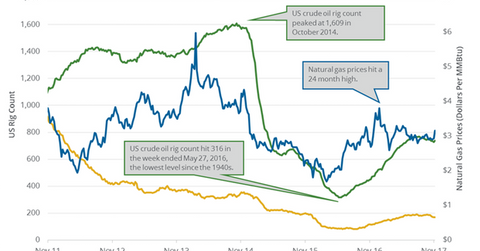Will US Crude Oil and Gas Rigs Pressure Natural Gas Futures?
Baker Hughes will publish its US crude oil and natural gas rig count report on November 17, 2017. The rigs were flat at 169 on November 3–10, 2017.
Nov. 17 2017, Published 9:44 a.m. ET

US natural gas rigs
Baker Hughes will publish its US crude oil and natural gas rig count report on November 17, 2017. In last week’s report, Baker Hughes reported that the rigs were flat at 169 on November 3–10, 2017. The rigs are near a seven-month low. The rigs have fallen by 23 or 12% since July 28, 2017. The rigs fell due to stalling oil (UWT) (DWT) and natural gas (UNG) (UGAZ) prices in the past few months.
Meanwhile, oil and natural gas are near a multi-month high. Higher oil (USO) and gas (UGAZ) (BOIL) prices benefit oil and gas producers’ (IEO) (FXN) earnings like Cabot Oil & Gas (COG), Diamond Offshore (DO), WPX Energy (WPX), and EQT (EQT).
Monthly drilling productivity report
The EIA released its monthly drilling report on November 13, 2017. It reported that US natural gas production would rise in the major shale regions by 779 Mcf (million cubic feet) per day to 61,705 Mcf per day in December 2017—compared to the previous month. Production is expected to rise in the Appalachia, Permian, and Haynesville shale regions during this period.
Impact
US gas rigs are at the lowest level since April 21, 2017. However, US crude oil prices near a 30-month high. Natural gas is usually a by-product of crude oil. Higher oil prices could drive US crude oil and gas rigs and supplies. US natural gas prices are near a six-month high. High gas prices would also drive natural gas rigs and US natural gas supplies, which could pressure natural gas prices.
In the next part, we’ll discuss US natural gas supply and demand.
